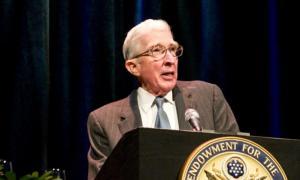John Updike Discusses American Art at 37th Annual Jefferson Lecture

Credit: ImageLinkPhoto/Dennis Kan

Credit: ImageLinkPhoto/Dennis Kan
“The Clarity of Things” lecture available on NEH Web site
John Updike, Pulitzer Prize-winning American novelist and internationally known author and critic, presented the 37th annual Jefferson Lecture in the Humanities in Washington last night. Nearly 2,000 guests were present at the Warner Theatre to hear Mr. Updike speak on American art. His lecture, “The Clarity of Things,” has been made available on the National Endowment for the Humanities (NEH) Web site.
Selection as Jefferson Lecturer is the most prestigious honor the federal government bestows for intellectual achievement in the humanities. One of the nation’s most distinguished authors and leading literary critics, Mr. Updike drew from his more recent experience as a critic of American art and chose for his subject to examine the connection between America’s art and its ideas in “The Clarity of Things.”
Mr. Updike featured in his lecture several works of art included in the Endowment’s new Picturing America initiative. Launched in February 2008, this program brings great American art to schools and public libraries to help citizens learn about the people, events, and ideas that have shaped our nation’s history.
“The Endowment is delighted to have John Updike, a true luminary in the firmament of American letters, speak on the subject of American art using selected examples from our Picturing America initiative,” said NEH Chairman Bruce Cole at last night’s event. “Picturing America was created in the belief that art both enhances life and provides direct insights into our nation’s history and character, and speaking from this same conviction, Mr. Updike has painted a compelling portrait of the American people.”
Using slides of over 60 works of American art from colonial America to the pop art movement of the twentieth century, John Updike engaged last night’s audience with a historically and visually rich exploration of artists ranging from Copley and Homer to Pollock and Rothko.
“Jonathan Edwards wrote of ‘the clarity of “things,”’ of things as the mediator between words and ideas, between empirical and conceptual experience,” said Mr. Updike during his lecture. He quoted the colonial theologian to support his thesis that America’s art is related, in part, to our nation’s founding Puritan vision of God, the world, and the nature of things. “The American artist, first born into a continent without museums and art schools, took Nature as his only instructor, and things as his principle study. A bias toward the empirical, toward the evidential object in the numinous fullness of its being, leads to a certain lininess, as the artist intently maps the visible in a New World that feels surrounded by chaos and emptiness.”
To view the complete text of the 37th Jefferson Lecture, read a conversation between Mr. Updike and Chairman Cole featured in the May/June 2008 issue of NEH’s Humanities magazine, and to find more information about John Updike and the Jefferson Lecture, please visit: www.neh.gov/about/awards/jefferson-lecture/john-updike-biography.
The annual Jefferson Lecture in the Humanities was established by the NEH in 1972. Created to honor the intellectual and civic virtues exemplified by Thomas Jefferson, the lectureship recognizes significant scholarship and the ability to communicate the knowledge and wisdom of the humanities in a broad, appealing way. The Jefferson Lecture is held each spring in Washington, D.C. The lecturer receives an honorarium of $10,000.